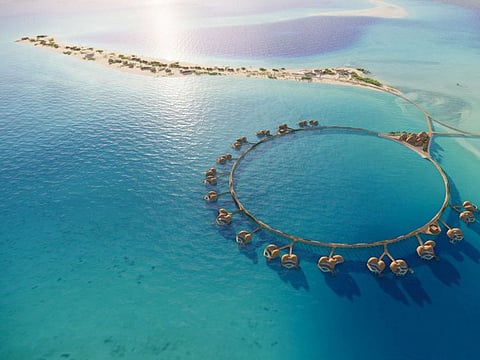For Saudi Arabia, tourism ambitions are all 'giga' in scale
Kingdom's Red Sea Project is building up scale across its 28,000 sq km landscape

Dubai: Check out the west and north-western parts on Saudi Arabia’s map. Come back in about a decade’s time to have a re-look. Chances are that you will not be able to recognise it as the Kingdom reshapes an entire region as part of its tourism development roadmap.
A sizeable portion of that will come in the form of the Red Sea Project, spanning a mind-boggling 28,000 square kilometres. A size and scale that go way beyond a ‘mega’ definition.
Welcome then to one of Saudi Arabia’s “giga-projects” in the making. “The giga-projects are part of a broader and more long-term diversification programme, which was already seeing the Kingdom open up and welcome tourists from all over the world,” said John Pagano, CEO of The Red Sea Development Company
“Tourism is expected to contribute 10 per cent to the country’s GDP by 2030, up from 3 per cent as it stands.
“Owned by Public Investment Fund (PIF), these projects are designed to become important hubs of discovery and inspiration that will stimulate the economy and shape the future of tourism in the Kingdom.”
But surely, the pandemic – and what it has done to the economy and its growth prospects - would have some bearing on those plans? Pagano was having none of that.
“The pandemic continues to create challenges for the tourism industry - but we are pleased to say we are still on track to meet our project milestones,” he added. “Despite these difficult circumstances, we have continued to make significant progress on the ground and more than 500 contracts worth over SR12.5 billion have been awarded to local and international partners.”
“With our destination on track to open as planned, we do not feel this will affect our progress in any considerable way.”
A taster of what’s planned
Clearly, this is much more than any mega-sized destination the Gulf has created in the last 20 years. Just to get some context of the Red Sea Project, it is expected to contribute up to SR100 billion to the GDP… during the construction phase.
And once fully operational, it will contribute SR22 billion a year to the economy. Now, that’s giga-sized alright…
By 2030, there will be 50 hotels within the Red Sea development, ranging from premium to hyper-luxury stay options. There will be multiple championship-grade golf courses as well as marinas and wellness spas.
One needn’t wait until the end of the decade to experience the place. Phase 1 is scheduled for completion in two years, and apart from 16 hotels – with 3,000 rooms on five islands and two in-land resorts - there will be a dedicated airport as well.
“Work on the airport has progressed significantly,” the CEO said. “Land levelling work for the new runways, taxiway and aprons is well underway and we have also completed construction of our new airport road, which will connect the airport to the destination.
“The airport’s architecture was informed by the natural beauty of the surrounding landscape and will have an eco-friendly design that supports our sustainability commitments.”
Volcanoes too
Beyond the hotels, future guests can choose from taking a trek to dormant volcanoes or hiking on desert trails by foot, on camel back, or “potentially in electric vehicles”.
If water is what holds interest for them, there’s the diving and snorkelling through coral reefs to “investigate life below the surface”. Plus, there’s always the “undiscovered culture of the area”.
“We are already in the planning stages for additional leisure facilities and attractions to be delivered within Phase 2,” he added.
Domestic push
This and other giga-destinations – NEOM City, AlUla, et al – will, in time, completely transform Saudi Arabia’s tourism prospects, which currently is reliant on religious tourists for much of the growth in recent years. Domestic tourism and hotel stays too will get an impetus from the cities and destinations being created. (Theme parks too are part of the Saudi makeover programme.)
“The Red Sea Project will welcome visitors from all over the world from the day it is open,” said Pagano. “Our international airport will be within eight hours flying time for 80 per cent of the world’s population, and western Europe within five to six hours.
“The annual number of visitors will be carefully managed and capped at one million to prevent over-tourism and protect the pristine landscape of The Red Sea Project.”
“We are seeing growing interest in people wanting to visit Saudi Arabia for the first time. Following the launch of the e-visa in September 2019, Ministry of Tourism issued more than 400,000 in the first six months and provided nearly 50 countries with new access to the Kingdom.”
Sign up for the Daily Briefing
Get the latest news and updates straight to your inbox







